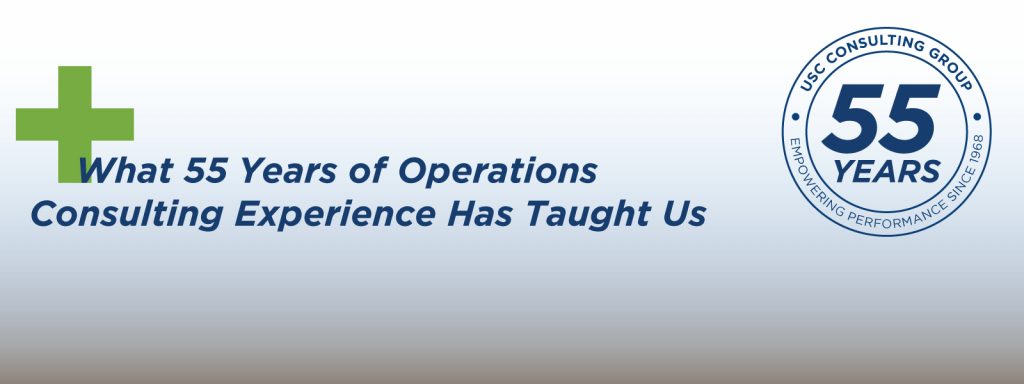
What 55 Years of Operations Consulting Experience Has Taught Us
We’re celebrating a milestone here at USC Consulting Group — 55 years partnering with businesses around the globe empowering their performance. Our goal is to help our clients drive operating excellence, increase throughput, become more efficient and boost their bottom lines.
We got our start in 1968 when founders Tom Rice and Pat Price founded a fully-engaged operations management consulting firm that strives to impart positive, impactful change to our clients. Back then, we were Universal Scheduling Company, communicating with clients over mimeograph and analyzing their schedules. We’ve grown quite a bit since those early days. Over the years, we expanded into other industries like mining & metals, food & beverage, life sciences, transportation & logistics and more. Our reach opened up to serve companies all around the globe. In 2001, we changed our name to USC Consulting Group to better reflect the breadth of our services and a few years later, relocated to Tampa, where our corporate headquarters is today.
That’s a tremendous growth story that we’re incredibly proud of.
During our half-century-plus in this business, we’ve seen a lot of changes come down the pike. The ups and downs of the economy, employment markets that wax or wane, the ongoing challenges brought on by the pandemic, technology advancements in machinery and tools for businesses we serve, and a whole host of other factors that ebb and flow during the passage of time.
We’ve rolled with it all and learned some valuable lessons along the way.
What has 55 years of consulting taught us?
Here are some of the top things we’ve learned during our 55 years in this business.
Experience matters, but every challenge we tackle for our clients is different. Many consulting firms dole out cookie-cutter solutions. But we’ve learned there is no such thing if you want to find sustainable results. Even if two businesses are in the same industry, they are not the same. We understand companies have unique processes, procedures, management styles, cultures, machinery, employees — you name it. So we go into every project with fresh eyes, knowing that what worked for others may not work again. There are too many variables to apply cookie-cutter solutions. That’s why we start by listening rather than talking to learn each client’s challenges before implementing improvements.
Upper management walking the shop floor is vital. We can recommend operations changes all day long, but the meat of the action happens day-to-day on the front lines, no matter the industry you’re in. If you’re a manager or in the C-suite, it’s so important to get down into the nitty-gritty of how their work gets done. You’ll get a better understanding of your operations, spot trouble sooner and also spot diamonds in the rough for promotion. You’ll hear great ideas to improve operations from the people who are actually doing the job, and when those employees are engaged, it leads to ultimate business success. Read more about it in “How to Increase Employee Engagement and Training to Improve Retention.”
Getting people onboard at the outset is a key element of success. Over the years, we’ve learned not everyone in a company is excited about process or operations improvements. Consultants can be viewed with skeptical eyes. That’s why we encourage engagement with employees at all levels, getting people on board early so employees understand they’re part of the solution, not part of the problem.
Going beyond Lean Six Sigma… Lean, which has been around forever and has recently migrated from the manufacturing floor into other industries (they’re even talking about Lean HR methods) and Six Sigma, a newer technique, are two methodologies for improving processes. Two sides of the same coin, Lean looks at making processes more efficient and reducing lead times, while Six Sigma focuses on cutting down on defects. The combination of the two produces powerful results. They’ve joined to become one methodology in some circles: Lean Six Sigma, or LSS, which aims to cut defects and shorten lead times. Striking the perfect balance between the two is tricky. It requires training and certification in the techniques. At USCCG, Dr. Frank Esposto is our Lean Six Sigma Master Black Belt and Senior Director of Quality. He is also a certified LSS instructor. Read more about it in our eBook, Lean Six Sigma: Do You Really Know These Methodologies?
…but we don’t just set it and forget it. Dr. Esposto says: “When we employ the Lean Six Sigma methodology to help our clients’ operations, we don’t simply do it for them. We train clients in these techniques so they can employ them long after we leave.” That goes for any process changes we help our clients make. It’s not about giving them a fish. It’s about teaching them to fish. That’s how lasting change happens and it’s a key differentiator between us and other consultants out there.
We could go on forever about lessons learned in a half-century plus. But the bottom line is, putting our customers’ needs squarely in the forefront of every engagement, understanding the marketplace and challenges the business faces, and focusing on people and processes will help your business reach a state of operational excellence.
Contact us today and let USC put our experience to work for you.






